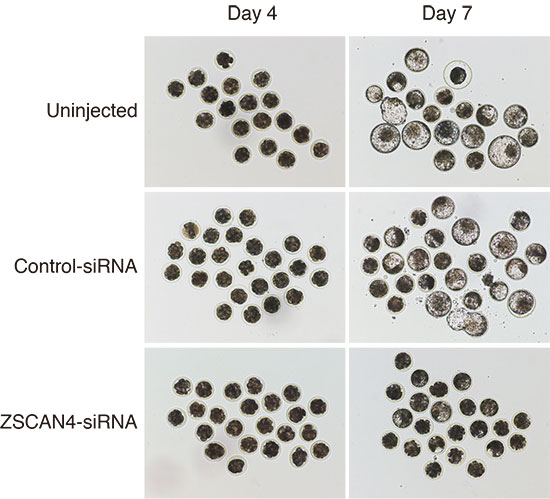- 著者
- Ken SAWAI
- 出版者
- The Society for Reproduction and Development
- 雑誌
- Journal of Reproduction and Development (ISSN:09168818)
- 巻号頁・発行日
- pp.2021-031, (Released:2021-04-27)
- 被引用文献数
- 3
In mammalian embryos, the first visible differentiation event is the segregation of the inner cell mass (ICM) and trophectoderm (TE) during the transition from the morula to the blastocyst stage. The ICM, which is attached to the inside of the TE, develop into the fetus and extraembryonic tissues, while the TE, which is a single layer surrounding the fluid-filled cavity called the blastocoel, will provide extraembryonic structures such as the placenta. ICM/TE differentiation is regulated by the interaction between various transcriptional factors. However, little information is available on the segregation of the ICM and TE lineages in preimplantation embryos of domestic animals, such as cattle and pigs. This review focuses on the roles of cell differentiation factors that regulate the ICM/TE segregation of preimplantation bovine and porcine embryos. Understanding the mechanism of cell differentiation in early embryos is necessary to improve the in vitro production systems for bovine and porcine embryos.
1 0 0 0 OA The necessity of ZSCAN4 for preimplantation development and gene expression of bovine embryos
- 著者
- Kazuki TAKAHASHI Pablo J. ROSS Ken SAWAI
- 出版者
- THE SOCIETY FOR REPRODUCTION AND DEVELOPMENT
- 雑誌
- Journal of Reproduction and Development (ISSN:09168818)
- 巻号頁・発行日
- pp.2019-039, (Released:2019-04-25)
- 被引用文献数
- 9
Zinc finger and SCAN domain containing 4 (Zscan4) is a gene that is specifically expressed during zygotic genome activation (ZGA) in mouse preimplantation embryos, and a reduction of Zscan4 transcripts leads to developmental failure. In mouse embryonic stem cells (ESCs), Zscan4 is expressed transiently in as little as 1–5% of the cell population. Zscan4 has also been shown to enhance the efficiency of mouse induced pluripotent stem cells (iPSCs) generation and their quality. Although ZSCAN4 plays important roles in murine embryos and stem cells, its expression and role in bovine embryos is unknown. This study examines ZSCAN4 transcripts in bovine embryos at various developmental stages and attempts to elucidate the functions of ZSCAN4 during bovine preimplantation development. ZSCAN4 transcripts were found to be upregulated at the 8- and 16-cell stages. We next attempted ZSCAN4 downregulation in bovine early embryos by RNA interference and evaluated developmental competency and transcripts levels of genes involved in ZGA and iPSCs generation. Although the bovine embryos injected with ZSCAN4-siRNA could develop to the 8-cell stage, very few were developing beyond the 16-cell stage. PIWIL2 expression was reduced in ZSCAN4 downregulated embryos. It is possible that ZSCAN4 downregulated embryos fail to regulate gene expression during ZGA. Our results indicate that ZSCAN4 is an important factor for the preimplantation development of bovine embryos.
- 著者
- Norikazu MIYASHITA Yasuaki KUBO Miharu YONAI Kanako KANEYAMA Norio SAITO Ken SAWAI Akira MINAMIHASHI Toshiyuki SUZUKI Toshiyuki KOJIMA Takashi NAGAI
- 出版者
- THE SOCIETY FOR REPRODUCTION AND DEVELOPMENT
- 雑誌
- Journal of Reproduction and Development (ISSN:09168818)
- 巻号頁・発行日
- pp.1108020393-1108020393, (Released:2011-08-05)
- 被引用文献数
- 6 13
Dolly, the first mammal cloned from a somatic cell, had shorter telomeres than age-matched controls and died at an early age because of disease. To investigate longevity and lifetime performance in cloned animals, we produced cloned cows with short telomeres using oviductal epithelial cells as donor cells. At 5 years of age, despite the presence of short telomeres, all cloned cows delivered multiple healthy offspring following artificial insemination with conventionally processed spermatozoa from noncloned bulls, and their milk production was comparable to that of donor cows. Moreover, this study revealed that the offspring had normal-length telomeres in their leukocytes and major organs. Thus, cloned animals have normal functional germ lines, and therefore germ line function can completely restore telomere lengths in clone gametes by telomerase activity, resulting in healthy offspring with normal-length telomeres.

